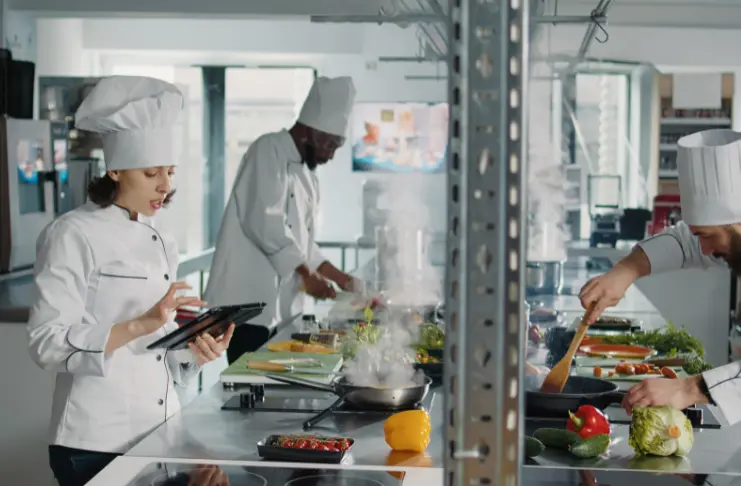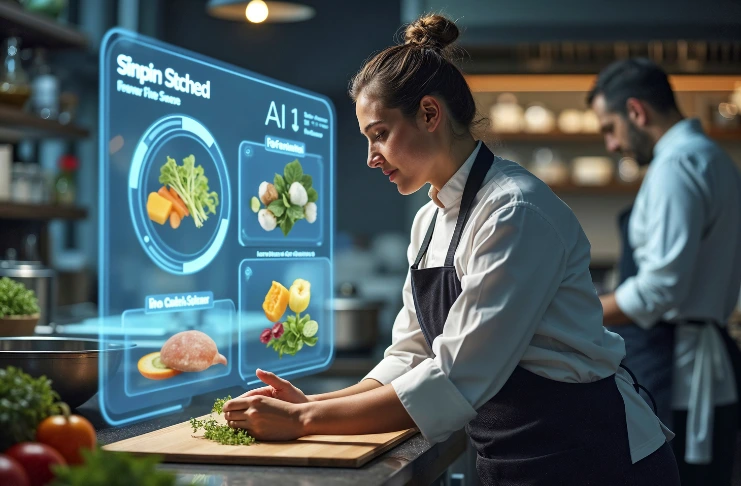They say the restaurant industry is a people-first business. True, but that’s only half the picture. Behind every plated dish and service lies a finely tuned engine of operations, the efficiency of which decides whether a restaurant wins or loses ground.
In 2025, approximately 95% of operators plan to invest in artificial intelligence to improve their operational efficiency. Most of them are streamlining their prep stations, automating inventory, and trimming menus for speed and profitability.
Why? Because operational efficiency today is no longer a back-of-office concern. When margins are tight, customers are impatient, and staff turnover is a constant, you’re expected to run a well-oiled machine.
This guide covers everything you must know to protect your margins, sharpen your performance, and future-proof your brand.
What Do We Really Mean by “Efficiency” in Restaurants?

At its core, restaurant efficiency represents a balance between resource utilization and output quality. It also means achieving the highest possible output with the least amount of wasted input, whether in terms of time, labor, inventory, or floor space.
Put simply:
Operational Efficiency = Output ÷ Input
restaurant’s operational efficiency
If you’re serving 120 guests during lunch with eight staff members instead of 12 or producing 90% of your revenue from 50% of your menu, you’re conventionally efficient.
However, in real life, the equation is never that clean. Factors like customer experience, staff morale, and seasonal variability often complicate the math.
So, what is true restaurant efficiency? It’s the ability to achieve consistent, high-quality outcomes with scalable systems that minimize food waste, empower staff, and enhance the customer experience, all while remaining flexible enough to adjust to real-time operational pressures.
Why Does Restaurant Efficiency Matter Now More Than Ever?

The past few years have drastically reshaped the food business sector. Supply chain instability, a 40% spike in core ingredient prices since 2020, and climbing labor costs have collectively compressed margins to historic lows. Today, many operators in the restaurant business are walking a tightrope between cost control and customer expectations.
Meanwhile, consumer behavior has also shifted. Diners expect speed, consistency, and customization in their dining experience, whether dining in, taking out, or ordering via third-party platforms. They want fresh, fast, and frictionless service and are willing to switch loyalties if expectations aren’t met.
Staffing remains one of the biggest hurdles. Widespread labor shortages and rising minimum wages have pushed restaurants to run leaner.
Add to that the surge in delivery platforms earning 15–30% commission per order, and suddenly, every minute, every step, and every square foot of your operation needs to pull its weight.
Sustainability concerns have also entered the equation, with waste reduction becoming both an environmental priority and a financial necessity. Every gram of food waste represents a profit margin being literally thrown away.
These challenges have rendered operational inefficiencies that might have been tolerable in previous years a threat to business viability. Thus, there is a need for even more focus on restaurant efficiency.
Common Myths Around Restaurant Efficiency

Before we get into the mechanics, let’s clear the air about persistent misconceptions that often derail restaurant efficiency improvement efforts. These myths not only impede progress but can actually damage your operation if left unchallenged.
Myth #1: “Efficiency means cutting costs.”
Truth: Cost-cutting is a tactic. Efficiency is a strategy. You can slash staff hours and still be inefficient if it leads to service delays, lower upsells, or higher turnover. Efficiency is about making every rupee or dollar work harder, not just spending less.
True efficiency often requires a strategic investment that generates exponential returns, whether in training, kitchen redesign, or smart technology. In fact, the most efficient restaurants sometimes spend more in certain areas to eliminate waste and friction elsewhere.
Myth #2: “You need more tech to be efficient.”
Not always. Tech is a multiplier, not a fix. If your systems are already broken, automating them just accelerates the chaos. So, it’s better to tighten your workflows first. Then, invest in tools that fit your operations, not the other way around.
When choosing the right tool, remember that the right technology amplifies good processes; it rarely creates them from scratch.
Myth #3: “Efficiency kills creativity.”
Wrong again. Efficient systems actually create space for creativity because your team isn’t constantly firefighting. When the basics run on rails, chefs can innovate, servers can upsell, and managers can focus on growth.
Successful restaurants often have rock-solid operational foundations that free mental bandwidth for creative thinking.
Myth #4: “Efficiency is only a BOH concern.”
Front-of-house inefficiencies like delayed seating, misfires on orders, and payment issues hurt your bottom line just as much as a clogged kitchen line.
That’s why efficiency must be end-to-end. A fast kitchen is meaningless if food sits in the pass or guests are left waiting to pay. Every guest-facing touchpoint is a chance to delight or derail.
Myth #5: “If it works now, don’t change it.”
That thinking kills scalability. What works in a 30-seat café will collapse in a 3-location model. Efficiency isn’t about what’s working today but what will keep working when the volume doubles.
Smart operators constantly test processes against higher volumes, tighter margins, and new formats. They embed scalable efficiency into their DNA from day one.
The hard truth? Many restaurants leave profit on the table by accepting operational inefficiencies as “just how the business works.” But in today’s market, that complacency can be fatal.
What Impacts Restaurant Efficiency? (The Core Drivers)

The key to achieving restaurant efficiency is to fix the system. That means identifying what’s broken, eliminating friction, and optimizing what’s underperforming. But what should you fix, exactly?
Here are the levers that actually move the needle:
1. Layout & Workflow Design
Your restaurant’s physical layout directly impacts how fast and effectively your team can move. Poor spatial planning, such as congested prep areas, cross-traffic between kitchen and service staff, or badly positioned POS stations, results in issues that slow down service and frustrate staff.
Fix:
Map high-traffic zones. Use workflow diagrams to understand how ingredients, dishes, and people move through the space. Streamline the movement between prep, cook, plate, and pass.
In FOH, separate order intake from food delivery wherever possible. Invest in ergonomic setups and space-saving designs that eliminate unnecessary steps.
2. Menu Engineering
Your menu is either streamlining your kitchen or sabotaging it. A bloated, complex menu often leads to longer ticket times, more inventory SKUs, and higher training requirements. Worse, it confuses guests and dilutes your brand positioning.
Fix:
Analyze your item-wise contribution margin and preparation complexity. Cut low performers that drain resources. Highlight high-margin, high-turnover menu items and dishes. Standardize recipes for consistency and speed. Design your menu to complement kitchen capacity, not compete with it. A well-engineered menu reduces waste, shortens prep time, and simplifies inventory management.
3. Labor Optimization

Labor is both your biggest expense and your biggest asset. Overstaffing eats into margins, and understaffing kills customer experience and morale. However, the deeper problem is relying on guesswork instead of hard data.
Fix:
Use sales trends, time-of-day analytics, and seasonal footfall data to optimize staffing levels. Invest in scheduling software. Cross-train employees so they can shift roles during rushes. Build SOPs to reduce reliance on senior staff. When labor planning is data-driven, you get more productivity per shift without overburdening your team.
4. Inventory & Prep Management
Inefficient inventory practices lead to spoilage, stockouts, overordering, and even theft, which is a major source of hidden waste in restaurants.
Fix:
Set par levels and review them weekly. Implement FIFO (First In, First Out) storage. Track prep yields and portion accuracy. Monitor consumption trends and adjust purchase cycles accordingly. Use predictive ordering tools to plan around holidays, events, and seasonality.
Good inventory control translates directly into fewer losses and more cash on hand.
5. Tech Stack Alignment

A scattered or underutilized tech stack adds complexity instead of reducing it. Fragmented systems create silos and inefficiencies, especially when data doesn’t sync across platforms.
Fix:
Audit your current tech stack—POS, KDS, inventory management, CRM, and scheduling tools—to identify redundancies or underused features. Choose systems that integrate with each other or use middleware to sync data. Ensure team training accompanies every new implementation.
6. Communication Systems
Miscommunication is one of the fastest ways to introduce inefficiency into your team and workflow. Verbal-only systems or a lack of documentation leave too much room for human error.
Fix:
Standardize communication flows between Back of House and Front of House. Use kitchen display systems (KDS) instead of handwritten dockets. Implement daily pre-shift huddles and post-shift recaps. Create visual SOPs for complex tasks.
7. Leadership Bandwidth
Managers should be driving performance, not constantly putting out fires. However, many end up stuck in reactive mode due to unclear delegation or the absence of documented processes.
Fix:
Systematize repeatable tasks. Delegate, where possible, using role-based responsibilities.
Freeing up leadership bandwidth will allow them to monitor metrics, coach staff, and implement long-term improvements that truly contribute to operational performance.
How Can You Improve Your Restaurant’s Efficiency?

Improving efficiency demands structured, intelligent planning and execution. This four-phase roadmap walks you through the complete roadmap, from understanding where you are to sustainably improving over time.
Phase 1: Assessment (Weeks 1–4)
You can’t fix what you don’t fully understand.
So, start by establishing a clear baseline of your current performance.
- Document where you stand. Gather existing performance metrics across financial, operational, and guest-facing areas.
- Run a full-spectrum efficiency audit. Look into labor use, equipment downtime, kitchen processes, and customer wait times.
- Benchmark externally. Compare your numbers to industry standards within your segment. This reveals blind spots.
- Engage your team. Collect insights from the floor staff and the kitchen crew. They know where friction builds up.
- Evaluate customer experience. Use surveys or mystery shoppers to assess how guests perceive service flow and timing.
- Map your processes. Create visual workflows for key operations, like ordering, prep, plating, and service, to identify inefficiencies.
- Audit your tech stack. Evaluate the role of POS, KDS, inventory, and reporting tools. Are they speeding things up or slowing you down?
Pro Tip: Create a weighted efficiency scorecard with 10–15 KPIs (key performance indicators) that span financial, operational, and experience-based metrics. This scorecard will become your performance baseline.
Phase 2: Strategic Planning (Weeks 5–8)
Assessment tells you what’s broken. Strategy tells you what’s worth fixing and how.
This is where you make decisions. Not all inefficiencies are created equal. Rank them by potential impact and effort required.
- Prioritize what matters most. Focus on gaps that impact your bottom line or guest experience.
- Identify quick wins. Target simple fixes that yield visible results—menu bottlenecks, POS lag, prep redundancies.
- Allocate resources. Define what’s needed in terms of time, money, and staff bandwidth.
- Build a realistic timeline. Break down improvements into manageable phases over the next 3–6 months.
- Plan internal messaging. Transparency builds trust. Keep your team informed on what’s coming and why.
- Set success criteria. For every initiative, define measurable outcomes.
- Anticipate resistance.
Phase 3: Execution (Weeks 9–16)
Now comes the hands-on work. This phase demands discipline, leadership, and agility.
- Pilot first, scale later. Test changes in one outlet, one shift, or one department.
- Train with intent. Don’t just teach new processes: explain why they matter and how success will be measured.
- Refine your systems. Reconfigure tech to align with new workflows. Upgrade where necessary.
- Rethink the space. Small layout shifts can significantly improve kitchen flow or order handoff.
- Trim the menu. Remove underperforming or high-effort items. Streamline for speed and consistency.
- Update documentation. Revise SOPs, checklists, and training materials to reflect new standards.
- Track reactions. Gather feedback from both staff and guests during implementation.
- Monitor live progress. Set up dashboards or tracking sheets. Visibility ensures accountability.
INDUSTRY INSIGHT
| Most restaurant operators are investing in the Tech stack to improve their operational inefficiencies. In fact, these investments will rise by 40% this year. What’s driving this shift? Labor shortages, rising costs, and higher guest expectations. The right tool is expected to streamline operations, reduce waste, and deliver the speed and consistency that today’s diners demand. |
Phase 4: Optimization & Sustainability (Weeks 17–24)

You’ve done the hard part; now make it last.
Don’t let the momentum fade once the changes are live. This phase is about locking in gains and building a culture of continuous improvement.
- Measure against your original scorecard. Where did you improve? Where did you fall short?
- Fine-tune. Use post-implementation data to tweak processes that aren’t fully landing.
- Celebrate wins. Recognize individuals and teams who helped move the needle. It reinforces the behavior you want.
- Capture the knowledge. Document what worked, what didn’t, and why. Make it replicable.
- Establish long-term monitoring. Monthly or quarterly check-ins help catch slippage early.
- Create an improvement loop. Efficiency isn’t a project—it’s a mindset. Enable team-driven suggestions and experiments.
- Scale success. Roll out proven changes to new locations, shifts, or service models.
Tip: Introduce a quarterly efficiency review cycle with designated team leads responsible for monitoring specific KPIs and recommending new improvements. Track core metrics like prime cost ratio, food and labor cost %, ticket time, cost per cover, return rate, etc.
Conclusion
The most operationally efficient restaurants worldwide recognize that efficiency isn’t a quarterly goal. It’s a philosophy informed by data, backed by systems, and driven by people who care about precision.
Frequently Asked Questions
1. How to be efficient in a restaurant?
To achieve efficiency in a restaurant, focus on optimizing processes, automating repetitive tasks, and maintaining clear communication across the team.
2. Why is restaurant efficiency important?
Restaurant efficiency is important because it directly impacts profitability, guest satisfaction, and staff productivity.
3. What are the three C’s in a restaurant?
The three C’s in a restaurant are Cost control, consistency in service, and customer experience.
4. What is operational efficiency in a restaurant?
Operational efficiency in a restaurant refers to the ability to deliver high-quality service while utilizing minimal time, labor, and resources.
5. What influences operational efficiency?
Several factors influence a restaurant’s operational efficiency, including menu design, staff training, kitchen layout, inventory control, and technology.
6. What are the challenges of operating a restaurant?
The most common challenges you may face when operating a restaurant are high labor turnover, rising costs, inventory waste, and inconsistent service standards.
7. What increases operational efficiency?
Operational efficiency can be increased via smart scheduling, automation tools, diligent performance tracking, and the creation of streamlined workflows.
8. How can restaurant operational efficiency be improved?
You can improve restaurant operational efficiency by conducting an audit, identifying bottlenecks, and implementing low-effort, high-impact changes.
9. How to efficiently run a restaurant?
To run a restaurant effectively, first set clear SOPs. Then, invest in training, focus on reducing waste, and keep your team aligned on goals.
10. How to increase productivity in a restaurant?
You can increase productivity in a restaurant by leveraging data to spot inefficiencies, cross-training your staff, and optimizing your prep and service timing.
11. What is efficiency and how can hotels and restaurants improve efficiency?
Efficiency means maximizing output with minimal waste. Hotels and restaurants can improve their efficiency through better planning, adopting automation, and establishing continuous feedback loops.
12. What are the 3 factors of operational efficiency?
The three key factors that contribute to operational efficiency are people, processes, and technology.





